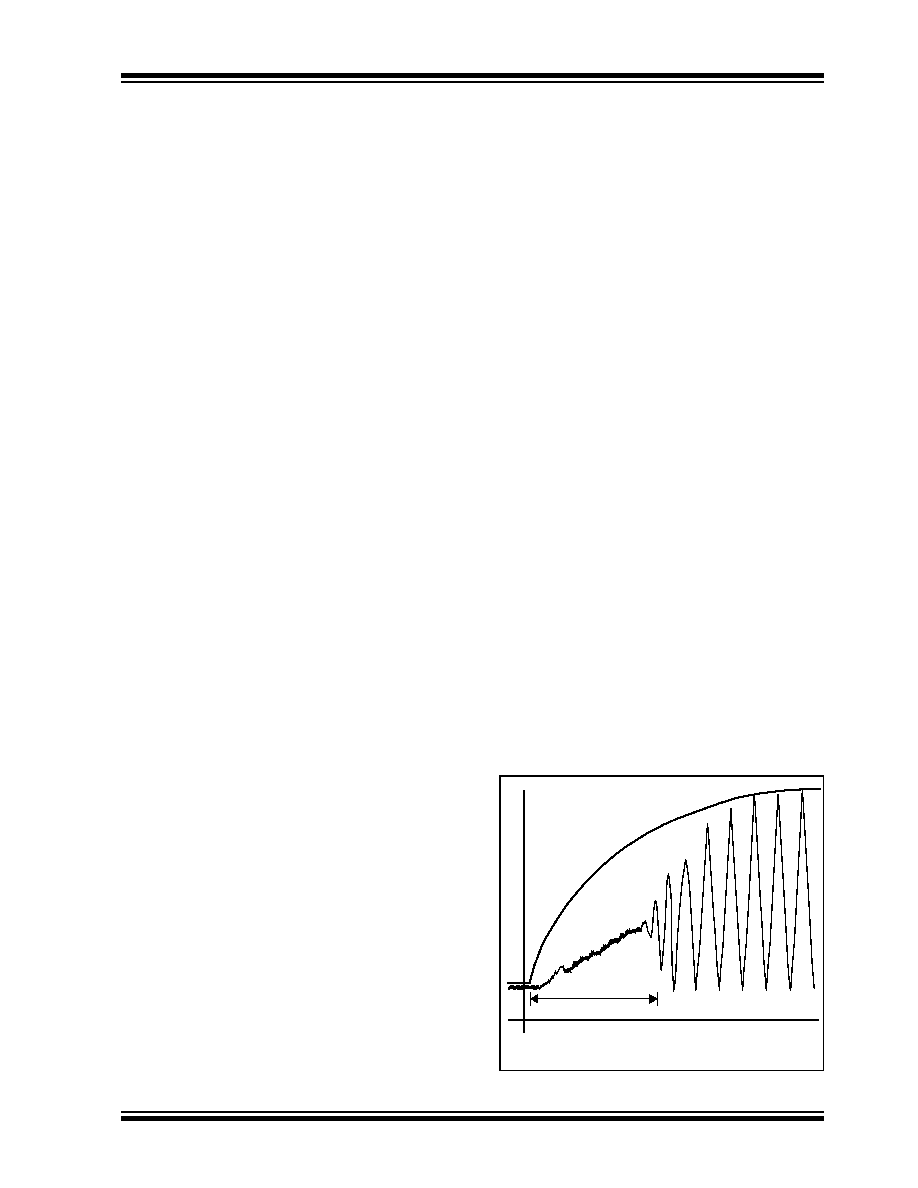- 您现在的位置:买卖IC网 > PDF目录3885 > PIC17C756AT-16E/L (Microchip Technology)IC MCU CMOS 16MHZ 16K EPRM68PLCC PDF资料下载
参数资料
| 型号: | PIC17C756AT-16E/L |
| 厂商: | Microchip Technology |
| 文件页数: | 39/159页 |
| 文件大小: | 0K |
| 描述: | IC MCU CMOS 16MHZ 16K EPRM68PLCC |
| 标准包装: | 300 |
| 系列: | PIC® 17C |
| 核心处理器: | PIC |
| 芯体尺寸: | 8-位 |
| 速度: | 16MHz |
| 连通性: | I²C,SPI,UART/USART |
| 外围设备: | 欠压检测/复位,POR,PWM,WDT |
| 输入/输出数: | 50 |
| 程序存储器容量: | 32KB(16K x 16) |
| 程序存储器类型: | OTP |
| RAM 容量: | 902 x 8 |
| 电压 - 电源 (Vcc/Vdd): | 4.5 V ~ 5.5 V |
| 数据转换器: | A/D 12x10b |
| 振荡器型: | 外部 |
| 工作温度: | -40°C ~ 125°C |
| 封装/外壳: | 68-LCC(J 形引线) |
| 包装: | 带卷 (TR) |
| 配用: | AC164308-ND - MODULE SKT FOR PM3 68PLCC DVA17XL681-ND - DEVICE ADAPTER FOR PIC17C752 DM173001-ND - KIT DEVELOPMENT PICDEM17 AC174007-ND - MODULE SKT PROMATEII 68PLCC AC164024-ND - ADAPTER PICSTART PLUS 68PLCC |
第1页第2页第3页第4页第5页第6页第7页第8页第9页第10页第11页第12页第13页第14页第15页第16页第17页第18页第19页第20页第21页第22页第23页第24页第25页第26页第27页第28页第29页第30页第31页第32页第33页第34页第35页第36页第37页第38页当前第39页第40页第41页第42页第43页第44页第45页第46页第47页第48页第49页第50页第51页第52页第53页第54页第55页第56页第57页第58页第59页第60页第61页第62页第63页第64页第65页第66页第67页第68页第69页第70页第71页第72页第73页第74页第75页第76页第77页第78页第79页第80页第81页第82页第83页第84页第85页第86页第87页第88页第89页第90页第91页第92页第93页第94页第95页第96页第97页第98页第99页第100页第101页第102页第103页第104页第105页第106页第107页第108页第109页第110页第111页第112页第113页第114页第115页第116页第117页第118页第119页第120页第121页第122页第123页第124页第125页第126页第127页第128页第129页第130页第131页第132页第133页第134页第135页第136页第137页第138页第139页第140页第141页第142页第143页第144页第145页第146页第147页第148页第149页第150页第151页第152页第153页第154页第155页第156页第157页第158页第159页

2000 Microchip Technology Inc.
DS30289B-page 17
PIC17C7XX
4.0
ON-CHIP OSCILLATOR
CIRCUIT
The internal oscillator circuit is used to generate the
device clock. Four device clock periods generate an
internal instruction clock (TCY).
There are four modes that the oscillator can operate in.
They are selected by the device configuration bits dur-
ing device programming. These modes are:
LF
Low Frequency (FOSC
≤ 2 MHz)
XT
Standard Crystal/Resonator Frequency
(2 MHz
≤ FOSC ≤ 33 MHz)
EC
External Clock Input
(Default oscillator configuration)
RC
External Resistor/Capacitor
(FOSC
≤ 4 MHz)
There are two timers that offer necessary delays on
power-up. One is the Oscillator Start-up Timer (OST),
intended to keep the chip in RESET until the crystal
oscillator is stable. The other is the Power-up Timer
(PWRT), which provides a fixed delay of 96 ms (nomi-
nal) on POR and BOR. The PWRT is designed to keep
the part in RESET while the power supply stabilizes.
With these two timers on-chip, most applications need
no external RESET circuitry.
SLEEP mode is designed to offer a very low current
power-down mode. The user can wake from SLEEP
through external RESET, Watchdog Timer Reset, or
through an interrupt.
Several oscillator options are made available to allow
the part to better fit the application. The RC oscillator
option saves system cost while the LF crystal option
saves power. Configuration bits are used to select var-
ious options.
4.1
Oscillator Configurations
4.1.1
OSCILLATOR TYPES
The PIC17CXXX can be operated in four different oscil-
lator modes. The user can program two configuration
bits (FOSC1:FOSC0) to select one of these four
modes:
LF
Low Power Crystal
XT
Crystal/Resonator
EC
External Clock Input
RC
Resistor/Capacitor
The main difference between the LF and XT modes is
the gain of the internal inverter of the oscillator circuit,
which allows the different frequency ranges.
For more details on the device configuration bits, see
4.1.2
CRYSTAL OSCILLATOR/CERAMIC
RESONATORS
In XT or LF modes, a crystal or ceramic resonator is con-
nected to the OSC1/CLKIN and OSC2/CLKOUT pins to
establish oscillation (Figure 4-2). The PIC17CXXX oscil-
lator design requires the use of a parallel cut crystal. Use
of a series cut crystal may give a frequency out of the
crystal manufacturers specifications.
For frequencies above 24 MHz, it is common for the
crystal to be an overtone mode crystal. Use of overtone
mode crystals require a tank circuit to attenuate the
gain at the fundamental frequency. Figure 4-3 shows
an example circuit.
4.1.3
OSCILLATOR/RESONATOR
START-UP
As the device voltage increases from Vss, the oscillator
will start its oscillations. The time required for the oscil-
lator to start oscillating depends on many factors.
These include:
Crystal/resonator frequency
Capacitor values used (C1 and C2)
Device VDD rise time
System temperature
Series resistor value (and type) if used
Oscillator mode selection of device (which selects
the gain of the internal oscillator inverter)
Figure 4-1 shows an example of a typical oscillator/
resonator start-up. The peak-to-peak voltage of the
oscillator waveform can be quite low (less than 50% of
device VDD) when the waveform is centered at VDD/2
(refer to parameter #D033 and parameter #D043 in the
electrical specification section).
FIGURE 4-1:
OSCILLATOR/
RESONATOR START-UP
CHARACTERISTICS
V
DD
Crystal Start-up Time
Time
相关PDF资料 |
PDF描述 |
|---|---|
| 1-84983-1 | CONN FFC 11POS 1.00MM R/A PCB |
| PIC17C756A-33E/PT | IC MCU CMOS 33MHZ 16K EPRM64TQFP |
| 1-84983-0 | CONN FFC 10POS 1.00MM R/A PCB |
| PIC17C756A-16E/PT | IC MCU CMOS 16MHZ 16K EPRM64TQFP |
| PIC17C756A-16E/L | IC MCU CMOS 16MHZ 16K EPRM68PLCC |
相关代理商/技术参数 |
参数描述 |
|---|---|
| PIC17C756AT-16I/L | 功能描述:8位微控制器 -MCU 32KB 902 RAM 50 I/O RoHS:否 制造商:Silicon Labs 核心:8051 处理器系列:C8051F39x 数据总线宽度:8 bit 最大时钟频率:50 MHz 程序存储器大小:16 KB 数据 RAM 大小:1 KB 片上 ADC:Yes 工作电源电压:1.8 V to 3.6 V 工作温度范围:- 40 C to + 105 C 封装 / 箱体:QFN-20 安装风格:SMD/SMT |
| PIC17C756AT-16I/PT | 功能描述:8位微控制器 -MCU 32KB 902 RAM 50 I/O RoHS:否 制造商:Silicon Labs 核心:8051 处理器系列:C8051F39x 数据总线宽度:8 bit 最大时钟频率:50 MHz 程序存储器大小:16 KB 数据 RAM 大小:1 KB 片上 ADC:Yes 工作电源电压:1.8 V to 3.6 V 工作温度范围:- 40 C to + 105 C 封装 / 箱体:QFN-20 安装风格:SMD/SMT |
| PIC17C756AT-33/L | 功能描述:8位微控制器 -MCU 32KB 902 RAM 50 I/O RoHS:否 制造商:Silicon Labs 核心:8051 处理器系列:C8051F39x 数据总线宽度:8 bit 最大时钟频率:50 MHz 程序存储器大小:16 KB 数据 RAM 大小:1 KB 片上 ADC:Yes 工作电源电压:1.8 V to 3.6 V 工作温度范围:- 40 C to + 105 C 封装 / 箱体:QFN-20 安装风格:SMD/SMT |
| PIC17C756AT-33/PT | 功能描述:8位微控制器 -MCU 32KB 902 RAM 50 I/O RoHS:否 制造商:Silicon Labs 核心:8051 处理器系列:C8051F39x 数据总线宽度:8 bit 最大时钟频率:50 MHz 程序存储器大小:16 KB 数据 RAM 大小:1 KB 片上 ADC:Yes 工作电源电压:1.8 V to 3.6 V 工作温度范围:- 40 C to + 105 C 封装 / 箱体:QFN-20 安装风格:SMD/SMT |
| PIC17C756AT-33E/L | 功能描述:8位微控制器 -MCU 32KB 902 RAM 50 I/O RoHS:否 制造商:Silicon Labs 核心:8051 处理器系列:C8051F39x 数据总线宽度:8 bit 最大时钟频率:50 MHz 程序存储器大小:16 KB 数据 RAM 大小:1 KB 片上 ADC:Yes 工作电源电压:1.8 V to 3.6 V 工作温度范围:- 40 C to + 105 C 封装 / 箱体:QFN-20 安装风格:SMD/SMT |
发布紧急采购,3分钟左右您将得到回复。